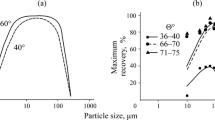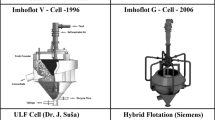Abstract
A series of flotation experiments were carried out in a 2.25-dm3 laboratory-scale Rushton turbine cell using hydrophobic quartz particles. Flotation was performed at a constant mean bubble diameter over a range of superficial gas velocities and impeller rotational speeds. The overall flotation rate constant increased linearly with increasing superficial gas velocity (and hence bubble surface area flux). The rate constant also increased linearly with increasing energy dissipation, until a maximum value was reached. A further increase in energy dissipation had little effect on the rate constant. The dependency of the rate constant on energy dissipation is a reflection of the size range and hydrophobicity of the particles used in this study. The flotation rate constant increased with increasing particle size, except at the highest energy dissipation value examined, for which the flotation rate of the larger particles reached a plateau and, in some cases, decreased. Good agreement was obtained between the experimental results and those predicted by a fundamental flotation model using experimentally measured values for mean energy dissipation and the Sauter mean bubble diameter. The bubble velocity was adjusted to obtain the best fit to the experimental data. The inferred bubble velocity, based on the flotation model, was found to increase with increasing superficial gas velocity (and bubble surface area flux) and was found to decrease with increasing impeller rotational speed. While the inferred bubble velocities were significantly lower than experimentally measured bubble velocities, and, except at low superficial gas velocity values, significantly higher than the bubble swarm velocity calculated from gas holdup measurements, similar trends with impeller rotational speed and superficial gas velocity were observed in all cases.
Similar content being viewed by others
Abbreviations
- d 32 :
-
Sauter mean bubble diameter
- Ea:
-
attachment efficiency
- Ec:
-
collision efficiency
- Es:
-
stability efficiency
- Jg:
-
superficial gas velocity
- k:
-
flotation rate constant
- k * :
-
undistributed flotation rate constant
- Np:
-
number of particles per unit volume
- p:
-
proportionality constant
- R:
-
recovery at time t
- Rmax:
-
maximum recovery
- Sb:
-
bubble surface area flux
- Zpb:
-
collision frequency between particles and bubbles
References
Cheng, Y.H., Mikhail, M.W., and Salama, A.I.A., 1995, “Effect of turbulence on the flotation of fine coal,” in Processing of Hydrophobic Minerals and Fine Coal, Laskowksi, J.S., and Poling G.W., eds., CIM, Montreal, pp. 425–434.
Cho, Y.S., and Laskowski, J.S., 2002, “Effect of flotation frothers on bubble size and foam stability,” Int. J. Miner. Process., Vol. 64, pp. 69–80.
Crawford, R., and Ralston, J., 1988, “The influence of particle size and contact angle in flotation,” Int. J. Miner. Process., Vol. 23, pp. 1–24.
Dai, Z., Dukhin, S., Fomasiero, D., and Ralston, J., 1998, “The inertial hydrody-namic interaction of particles and rising bubbles with mobile surfaces,” J. Colloid Interface Sci., Vol. 197, pp. 275–292.
Dai, Z., Fomasiero, D., and Ralston, J., 1999, “Particle-bubble attachment in mineral flotation,” J. Colloid Interface Sci., Vol. 217, pp. 70–76.
Deglon, D.A., 2002, “A novel attachment–detachment kinetic model,” in Flotation + Flocculation from Fundamentals to Applications, Ralston, J., Miller, J. D., and Rubio, J., eds., Hawaii, pp. 109–116.
Deglon, D.A., 2005, “The effect of agitation on the flotation of platinum ores,” Minerals Engineering, Vol. 18, pp. 839–844.
Deglon, D.A., O’ Connor, C.T., and Pandit, A.B., 1998, “Efficacy of a spinning disc as a bubble break-up device,” Chem. Eng. Sci., Vol. 53, pp. 59–70.
Deglon, D.A., Sawyerr, F., and O’Connor, C.T., 1999, “A model to relate the flotation rate constant and the bubble surface area flux in mechanical flotation cells,” Minerals Engineering, Vol. 12, pp. 599–608.
Diggins, D., Fokkink, L.G.L., and Ralston, J., 1990, “The wetting of angular quartz particles: capillary pressure and contact angle,” Colloids Surf., Vol. 44, pp. 299–313.
Dobby, G.S., and Finch, J.A., 1987, “ Particle size dependence in flotation derived from a fundamental model of the capture process,” Int. J. Miner. Process., Vol.21, pp. 241–260.
Duan, J., Fomasiero, D., and Ralston, J., 2003, “Calculation of the flotation rate constant of chalcopyrite particles in an ore,” Int. J. Miner. Process., Vol. 72, pp. 227–237.
Finch, J.A., and Dobby, G.S., 1990, Column Flotation, Pergamon Press, Elmsford, New York, p. 16.
Gorain, B.K., Franzidis, J.P., and Manlapig, E., 1997, “Studies on impeller type, impeller speed and air flow rate in an industrial scale flotation cell. Part 4: effect of bubble surface area flux on flotation performance,” Minerals Engineering, Vol. 10, pp. 367–379.
Heiskanen, K., 2000, “On the relationship between flotation rate and bubble surface area flux,” Minerals Engineering, Vol. 13, pp. 141–149.
Jameson, G.J., and Ahmed, N., 1983, “Improving the rate of flotation of fine particles,” ChEMECA 83, Brisbane, pp. 203–208.
Jordan, C.E., and Spears, D.R., 1990, “Evaluation of a turbulent flow model for fine-bubble and fine-particle flotation,” Minerals & Metallurgical Processing, May, pp. 65–73.
Nesse, T., Schubert, H., and Mockel, H.-O., 1979, “Tubulenzmessung in Meh-rphasenstromungen gasformig/flussig and fest/flussig mittels einer Piez-sonde,” 2nd European Symposium on Particle Measurement Techniques, Numberg, pp. 431–445.
Newell, R., andGrano, S., 2006, “Hydrodynamics and scale-up in Rushton turbine flotation cells: Part 2—Flotation scale-up for laboratory and pilot cells,” Int. J. Miner. Process., Vol. 81, pp. 65–78.
Newell, R., and Grano, S., 2007, “Hydrodynamics and scale-up in Rushton turbine flotation cells: Part 1—Cell hydrodynamics,” Int. J. Miner. Process., Vol. 81, pp. 224–236.
Parthasarathy, R., Jameson, G.J., and Ahmed, N., 1991, “Bubble breakup in stirred vessels—predicting the Sauter mean diameter,” Trans IChemE, Vol. 69, Part A, pp. 295–301.
Pyke, B.L., Duan, J., Fomasiero, D., and Ralston, J., 2002, “From turbulence and collision to attachment and detachment: a general flotation model,” in Flotation + Flocculation from Fundamentals to Applications, Ralston, J., Miller, J.D., and Rubio, J., eds., Hawaii, pp. 77–89.
Pyke, B.L., Fomasiero, D., and Ralston, J., 2003, “Bubble particle heterocoagula-tion under turbulent conditions,” J. Coll. Int. Sci., Vol. 265, pp. 141–151.
Savassi, O.N., Alexander, D.J., Franzidis, J.P., and Manlapig, E.., 1998, “An empirical model for entrainment in industrial flotation plants,” Minerals Engineering, Vol. 11, pp. 243–256.
Schubert, H., 1986, “On the hydrodynamics and scale-up of flotation processes,” in Advances in Mineral Processing, Somasundaran, P., ed., Society of Mining Engineers, Littleton, Colorado, pp. 636–649.
Schubert, H., and Bischofberger, C., 1978, “On the hydrodynamics of flotation machines,” Int. J. Miner. Process., Vol. 5, pp. 131–142.
Schubert, H., and Bischofberger, C., 1979, “On the optimization of hydrodynamics in flotation processes,” Proceedings Part B, XIIIIMPC, Warsaw, Laskowski, J., ed., pp. 1261–1285.
Schulze, H.J., 1993, “Flotation as a heterocoagulation process: possibilities of calculating the probability of flotation,” Surfactant Science Series (Coagulation and Flocculation),” Vol. 47, Marcel Dekker, New York, Chapter 7, pp. 321–354.
Spears, D.R.,and Jordan, C.E., 1989, “The effect of turbulence on the flotation of galena when using fine bubbles,” in Advances in Coal and Mineral Processing using Flotation, Soc. Min. Engrs. Of AIME, Littleton, CO., pp 77–84.
Sweet, C., van Hoogstraten, J., Harris, M., and Laskowski, J.S., 1997, “The effect of frothers on bubble size and f rothability of aqueous solutions,” in Processing of Complex Ores, Proc. 2nd UBC-McGill Int. Symp., Finch, J.A., Rao, S. R., and Holubec, I., eds., Met Soc of CIM, Montreal, pp. 235–245.
Trahar, W.J., 1981, “A rational interpretation of the role of particle size in flotation,” Int. J. Miner. Process., Vol. 8, pp. 289–327.
Zhou, G., and Kresta, S.M., 1996, “Impact of tank geometry on the maximum turbulence energy dissipation rate for impellers,” AlChE Journal, Vol. 42, pp. 2476–2490.
Author information
Authors and Affiliations
Additional information
Paper number MMP-06-053. Discussion of thiS peer-revlewed and approved paper is invited and must be submitted to SME Publications Dept. prior to Feb. 29, 2008.
Rights and permissions
About this article
Cite this article
Newell, R., Grano, S. Model and experimental study of the effect of impeller rotational speed on the flotation rate from a small-scale flotation cell — implications for the effect of bubble velocity. Mining, Metallurgy & Exploration 24, 157–169 (2007). https://doi.org/10.1007/BF03403211
Received:
Revised:
Accepted:
Published:
Issue Date:
DOI: https://doi.org/10.1007/BF03403211




